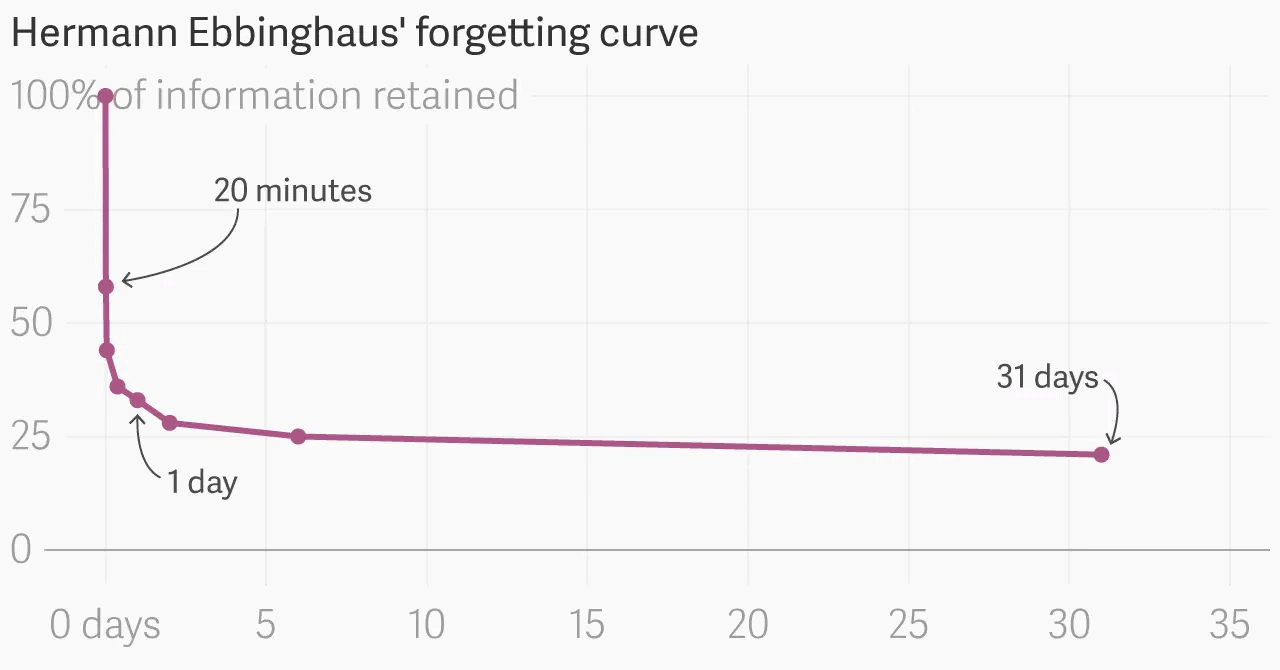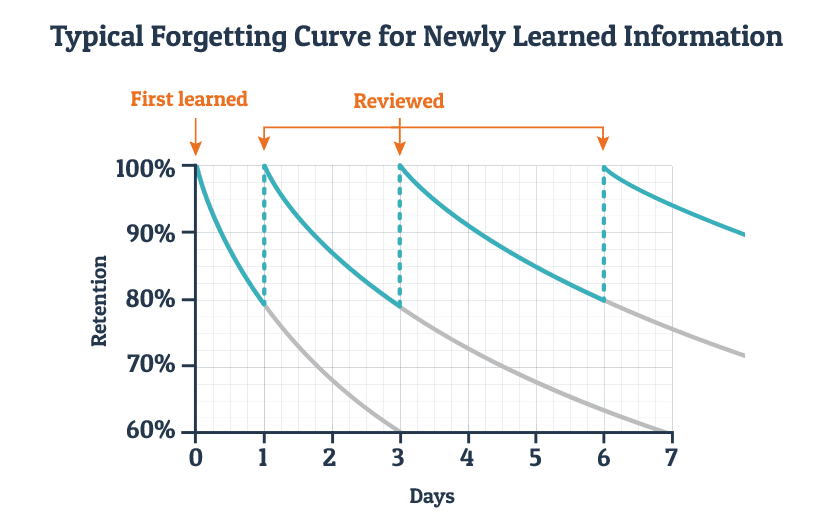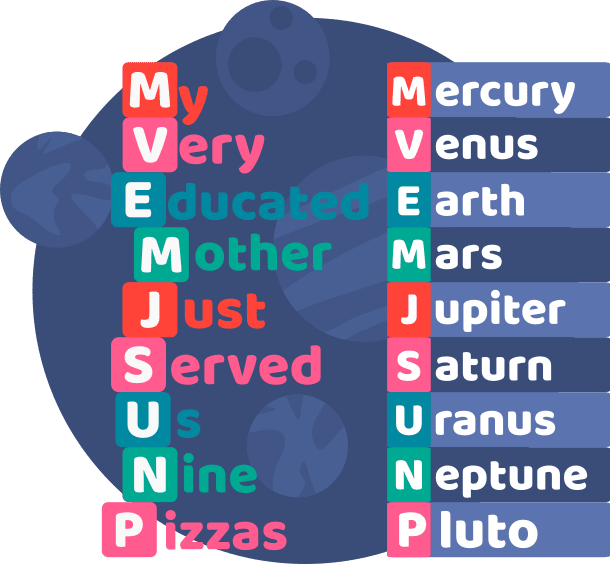You might have experienced this before: you cram for an exam, feeling confident about the material, only to forget most of it just a few days later. Why does this happen? Well, let me introduce you to the Ebbinghaus Forgetting Curve, a concept that might shed some light on this phenomenon.
What is the Ebbinghaus Forgetting Curve?

The Ebbinghaus forgetting curve is a graphical representation of the forgetting process. The curve demonstrates the declining rate at which information is lost if no particular effort is made to remember it. The forgetting curve was defined in 1885 by German psychologist Hermann Ebbinghaus (1850-1909) in his book Memory.
Ebbinghaus was the first psychologist who systematically studied memory and learning. He recorded his findings mathematically in an attempt to discover patterns of forgetting and memory retention.
Now, imagine a graph where the vertical axis represents how well you remember something, and the horizontal axis represents time. Right after learning, you're at the peak of the graph, but as time goes on, your memory of that information starts to decline, creating a curve that dips downward.
This isn't just about forgetting what you studied for a test... it's a fundamental aspect of how our brains process and store information. The steeper the curve, the faster you forget.
By recognizing the natural decline of memory retention, you can implement strategies like spaced repetition to reinforce what you've learned. This way, instead of feeling frustrated by what you've forgotten, you can harness the power of psychology to make your learning more effective and long-lasting.
In fact, you can test this curve yourself by taking and graphing the results of our memory test.
Ebbinghaus’ experimental method, like that of many of his peers, consisted of conducting a series of extensive tests on himself. He created hundreds of three-letter words, or “nonsense syllables” as he called them, like “wid”, “zof”, and “qax.”
The psychologist then tried to memorize lists made of these words and determined for how long he could remember them after different time intervals. He plotted his results in a graph that we know today as the forgetting curve.
Rate of forgetting

Ebbinghaus found that the forgetting curve is exponential in nature. It starts off very steep—the amount of retained knowledge drops dramatically soon after we acquire new information. In fact, most of the forgetting occurs within the first hour of learning. And that’s not all. After a day or two, we typically forget around 75% of what we have learned.
Without any additional work, we will quickly forget most of the content of a course, for instance. A week later, it will be as if the learning had never occurred at all.
Fortunately, there is a point at which the forgetting rate starts to decline at a slower pace. After a day or so, it usually levels off. This is when we can partially absorb essential details and store them in our long-term memory. In other words, the day after taking a course, we will retain only a few details but we will be able to remember them for several more days.
Contributing factors
According to Ebbinghaus, the basic forgetting rate doesn’t differ significantly between individuals. Still, this rate can be influenced to a certain extent by a myriad of different factors.
Prior Knowledge and Meaningfulness of the Subject
If we can connect a lecture to information that is already encoded in our long-term memory, we are more likely to remember it. Our connections to previous knowledge give this information meaning. Research shows that we are more likely to remember information, and remember it for a longer period of time when we give it meaning.
Similarly, if believe that the information has meaning, whether we have prior knowledge of it or not, it is likely to stick. When our minds believe that something is important, we are more likely to keep our focus on it. If your parent tells you not to forget the phone number they recite to you, you are more likely to hold onto it in your memory instead of listening to the radio or thinking about a casual conversation you had 20 minutes prior.
The Complexity of the Material
Before memories are stored as long-term or even short-term memories, they exist in our working memory. Working memory contains information that we are currently “working” with, and if we focus on it for long enough, it will make its way to other types of memory storage. Working memory is limited to only a few items.
For this reason, complex material may be hard to remember. Our working memory can only focus on so much before it discards the information. If we have nothing to connect complex material to or cannot focus on it for a long period of time, it will get lost.
This doesn’t mean we can’t learn complex material. We just have to find ways to break down the material into pieces of information that we can work with and remember. Building a strong foundation in a subject will make it easier to take in complex concepts.
How the Information Is Presented
The person presenting the information also impacts whether the information will “stick.” Simplicity is key to presenting information, but other factors also influence how complex, meaningful, or memorable it is.
If you want to present meaningful information, follow these guidelines.
- Repeat the information over and over. Repetition makes information stick.
- Tell the information as if it’s a story. People follow the format of stories. They know stories have a beginning, middle, end, and problem that is ultimately solved. If you can position the information in this way, your audience is more likely to follow and attach meaning.
- Be clear and confident. When you are clear about the information, there is little room for the audience to question your information or to search for a deeper meaning in it.
Individual Capability
Some people naturally have a better memory than others! Genetics isn’t the only factor that influences memory, but it does play a role. If you are someone that doesn’t naturally have a great memory, you can still take steps to take care of your brain and learn your material in effective ways. Taking care of your body and mind will take care of your memory.
Physiological Factors (Lack of Sleep, Hunger, etc.)
Did you know that sleep “resets” the brain? Sleep is crucial for memory storage and brain health. Getting eight hours of sleep a night can improve your ability to restore memories from the day before. If you’re getting very few hours of sleep every night, you may be overworking your brain and preventing it from storing memories properly!
Other physiological factors may also play a role in memory. Recently, scientists discovered that the “hunger hormone” plays a big role in episodic memory. But this doesn’t mean that you should starve yourself before a lecture just to remember the material. Scientists are still looking into how the hunger hormone, the vagus nerve, and long-term memory work together (or against each other!)
Psychological Factors (Stress, Anxiety, etc.)
Stress and anxiety can negatively affect your ability to form and store memories. If you are under great stress during an event, you may not be able to remember it. Details may be fuzzy, or you may not pick up on everything that was happening around you leading up to, or after, an event.
Knowing this connection between stress and memory is crucial for people who may want to retrace their steps or restore memories of an event. When we recall memories, we want to have all the details. When we don’t, our brains fill in the details for us. These details may not always be accurate. People can create false memories when they are under stress or trying to recall stressful memories from their lives.
Overcoming the Forgetting Curve
While some aspects that contribute to the speed of forgetting cannot be changed, Ebbinghaus proposed the use of two methods when we purposefully acquire new skills or knowledge: mnemonic techniques and repetitions. Implementing these strategies can help us overcome the forgetting curve.
Mnemonic techniques
Mnemonic learning techniques rely on “repackaging” of the information, a process that helps the brain to store the information and find it again when needed. This strategy is based on creating associations with something that is easy to remember. For example, mnemonics use images, emotions, patterns, or rhymes like the alphabet song, to help us absorb the information more efficiently.
You probably have used these techniques before in school. "Every Good Boy Does Fine" helps music students figure out how to read music. "PEMDAS," or "Please Excuse My Dear Aunt Sally," spells out the order of operations in math. We remember them, years after we graduated high school, because they're so memorable!

Repetitions of information
Ebbinghaus showed that repeating and reviewing the acquired knowledge helps strengthen our memory. It is clear from the forgetting curve pattern that the initial repetition of the information should ideally occur within the first day of learning.
But this is not enough. While an initial review of what we’ve learned certainly helps us remember the details in the short term, reviewing multiple times will enable us to retain them for much longer. Each time we revisit the same material, we retain larger chunks of information. As a result, the forgetting curve will start flattening out at a much higher level. That means we will forget at a slower pace.
In order to retain knowledge and fully embed the learned material into our long-term memory, we have to periodically review the information. Research indicates that a minimum of three reviews is necessary for obtaining the best results.
Ebbinghaus argued that each subsequent repetition increases the time needed before the next one. This is called spaced learning.
How to Use the Ebbinghaus Forgetting Curve with Spaced Learning
For Ebbinghaus, overcoming the forgetting curve had more to it than just simple repetitions.
Repetitions have to be spaced for optimal effect. Repeating new facts many times within an hour is not useful in overcoming the forgetting curve. If we are not required to make any attempt to recall and retrieve the information, the improvement is impossible because the memory hasn’t had a chance to decay. At the same time, if the information is repeated too infrequently, retention and recall will fail. In this case, we will have to start the learning process all over again.
However, when the material is being repeated at strategically spaced intervals, the brain reconstructs the memory and strengthens it in the process. These specific time intervals between multiple learning sessions are essential. They allow the brain to recover between repetitions and consolidate the learning.
We can recall information and concepts better if we learn them in the course of several spread-out sessions.
Spaced learning is much more effective than massed learning where we try to cram all the information into a short period of time. In fact, the massed learning technique turns out to be hugely counterproductive. Spaced learning, on the contrary, enables us to better manage the information that is retained and increase our long-term productivity. It leads to a better overall learning experience and ultimately allows us to reshape the forgetting curve.
It is not necessary to review the information in exactly the same way in which the initial learning occurred. Presenting the same concept in a slightly different form like a video or exercise is just as efficient in strengthening the memory and overcoming the Ebbinghaus forgetting curve.
